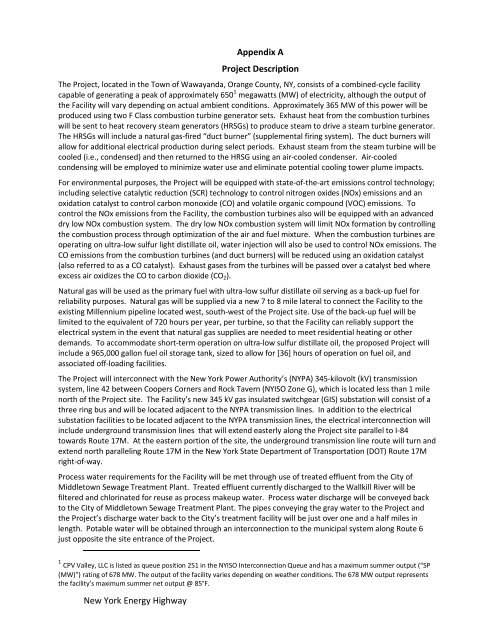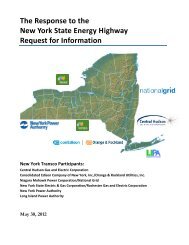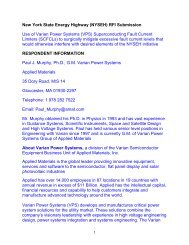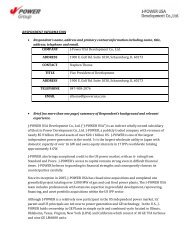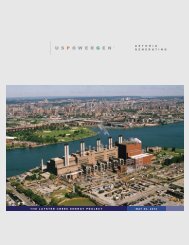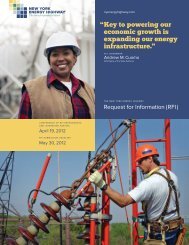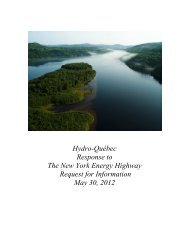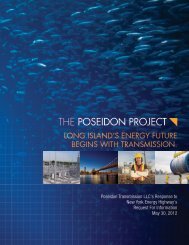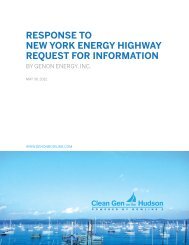Competitive Power Ventures, Inc. - Energy Highway
Competitive Power Ventures, Inc. - Energy Highway
Competitive Power Ventures, Inc. - Energy Highway
You also want an ePaper? Increase the reach of your titles
YUMPU automatically turns print PDFs into web optimized ePapers that Google loves.
Appendix A<br />
Project Description<br />
The Project, located in the Town of Wawayanda, Orange County, NY, consists of a combined-cycle facility<br />
capable of generating a peak of approximately 650 1 megawatts (MW) of electricity, although the output of<br />
the Facility will vary depending on actual ambient conditions. Approximately 365 MW of this power will be<br />
produced using two F Class combustion turbine generator sets. Exhaust heat from the combustion turbines<br />
will be sent to heat recovery steam generators (HRSGs) to produce steam to drive a steam turbine generator.<br />
The HRSGs will include a natural gas-fired “duct burner” (supplemental firing system). The duct burners will<br />
allow for additional electrical production during select periods. Exhaust steam from the steam turbine will be<br />
cooled (i.e., condensed) and then returned to the HRSG using an air-cooled condenser. Air-cooled<br />
condensing will be employed to minimize water use and eliminate potential cooling tower plume impacts.<br />
For environmental purposes, the Project will be equipped with state-of-the-art emissions control technology;<br />
including selective catalytic reduction (SCR) technology to control nitrogen oxides (NOx) emissions and an<br />
oxidation catalyst to control carbon monoxide (CO) and volatile organic compound (VOC) emissions. To<br />
control the NOx emissions from the Facility, the combustion turbines also will be equipped with an advanced<br />
dry low NOx combustion system. The dry low NOx combustion system will limit NOx formation by controlling<br />
the combustion process through optimization of the air and fuel mixture. When the combustion turbines are<br />
operating on ultra-low sulfur light distillate oil, water injection will also be used to control NOx emissions. The<br />
CO emissions from the combustion turbines (and duct burners) will be reduced using an oxidation catalyst<br />
(also referred to as a CO catalyst). Exhaust gases from the turbines will be passed over a catalyst bed where<br />
excess air oxidizes the CO to carbon dioxide (CO 2 ).<br />
Natural gas will be used as the primary fuel with ultra-low sulfur distillate oil serving as a back-up fuel for<br />
reliability purposes. Natural gas will be supplied via a new 7 to 8 mile lateral to connect the Facility to the<br />
existing Millennium pipeline located west, south-west of the Project site. Use of the back-up fuel will be<br />
limited to the equivalent of 720 hours per year, per turbine, so that the Facility can reliably support the<br />
electrical system in the event that natural gas supplies are needed to meet residential heating or other<br />
demands. To accommodate short-term operation on ultra-low sulfur distillate oil, the proposed Project will<br />
include a 965,000 gallon fuel oil storage tank, sized to allow for [36] hours of operation on fuel oil, and<br />
associated off-loading facilities.<br />
The Project will interconnect with the New York <strong>Power</strong> Authority’s (NYPA) 345-kilovolt (kV) transmission<br />
system, line 42 between Coopers Corners and Rock Tavern (NYISO Zone G), which is located less than 1 mile<br />
north of the Project site. The Facility’s new 345 kV gas insulated switchgear (GIS) substation will consist of a<br />
three ring bus and will be located adjacent to the NYPA transmission lines. In addition to the electrical<br />
substation facilities to be located adjacent to the NYPA transmission lines, the electrical interconnection will<br />
include underground transmission lines that will extend easterly along the Project site parallel to I-84<br />
towards Route 17M. At the eastern portion of the site, the underground transmission line route will turn and<br />
extend north paralleling Route 17M in the New York State Department of Transportation (DOT) Route 17M<br />
right-of-way.<br />
Process water requirements for the Facility will be met through use of treated effluent from the City of<br />
Middletown Sewage Treatment Plant. Treated effluent currently discharged to the Wallkill River will be<br />
filtered and chlorinated for reuse as process makeup water. Process water discharge will be conveyed back<br />
to the City of Middletown Sewage Treatment Plant. The pipes conveying the gray water to the Project and<br />
the Project’s discharge water back to the City’s treatment facility will be just over one and a half miles in<br />
length. Potable water will be obtained through an interconnection to the municipal system along Route 6<br />
just opposite the site entrance of the Project.<br />
1 CPV Valley, LLC is listed as queue position 251 in the NYISO Interconnection Queue and has a maximum summer output (“SP<br />
(MW)”) rating of 678 MW. The output of the facility varies depending on weather conditions. The 678 MW output represents<br />
the facility’s maximum summer net output @ 85°F.<br />
New York <strong>Energy</strong> <strong>Highway</strong>


